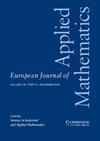多孔弹性薄膜在可变形板上干燥的时间相关模型
IF 1.1
4区 数学
Q1 MATHEMATICS, APPLIED
引用次数: 0
摘要
了解机械应力的产生在干燥,颗粒负载薄膜是重要的广泛的工业过程。研究这些应力的一种方法是通过悬臂实验,将薄膜沉积在薄板的表面,薄板的一端夹在墙上。干燥过程中膜内产生的应力传递给印版,带动弯曲。数学模型使薄膜应力可以从板挠度的测量推断出来。本文的目的是利用渐近方法从连续介质力学的时间相关方程中推导出悬臂梁实验的简化模型。薄膜用非线性孔隙弹性来描述,板用非线性弹性来描述。与stone -like公式相比,简化模型考虑了薄膜厚度和应力不均匀的情况。薄膜模型可简化为可独立于平板方程求解的单一微分方程。该板块模型简化为Föppl-von Kármán (FvK)方程的扩展形式,该方程考虑了作用于板块表面的纵向牵引力梯度。通过解析板自由边缘的Saint-Venant边界层,导出了FvK方程的一致边界条件。渐近简化模型与完整控制方程的有限元解非常吻合。随着psamclet数的增加,板挠度的时间演化由$t$变为$t^{1/2}$,与实验结果一致。本文章由计算机程序翻译,如有差异,请以英文原文为准。
Time-dependent modelling of thin poroelastic films drying on deformable plates
Understanding the generation of mechanical stress in drying, particle-laden films is important for a wide range of industrial processes. One way to study these stresses is through the cantilever experiment, whereby a thin film is deposited onto the surface of a thin plate that is clamped at one end to a wall. The stresses that are generated in the film during drying are transmitted to the plate and drive bending. Mathematical modelling enables the film stress to be inferred from measurements of the plate deflection. The aim of this paper is to present simplified models of the cantilever experiment that have been derived from the time-dependent equations of continuum mechanics using asymptotic methods. The film is described using nonlinear poroelasticity and the plate using nonlinear elasticity. In contrast to Stoney-like formulae, the simplified models account for films with non-uniform thickness and stress. The film model reduces to a single differential equation that can be solved independently of the plate equations. The plate model reduces to an extended form of the Föppl-von Kármán (FvK) equations that accounts for gradients in the longitudinal traction acting on the plate surface. Consistent boundary conditions for the FvK equations are derived by resolving the Saint-Venant boundary layers at the free edges of the plate. The asymptotically reduced models are in excellent agreement with finite element solutions of the full governing equations. As the Péclet number increases, the time evolution of the plate deflection changes from
$t$
to
$t^{1/2}$
, in agreement with experiments.
求助全文
通过发布文献求助,成功后即可免费获取论文全文。
去求助
来源期刊
CiteScore
4.70
自引率
0.00%
发文量
31
审稿时长
>12 weeks
期刊介绍:
Since 2008 EJAM surveys have been expanded to cover Applied and Industrial Mathematics. Coverage of the journal has been strengthened in probabilistic applications, while still focusing on those areas of applied mathematics inspired by real-world applications, and at the same time fostering the development of theoretical methods with a broad range of applicability. Survey papers contain reviews of emerging areas of mathematics, either in core areas or with relevance to users in industry and other disciplines. Research papers may be in any area of applied mathematics, with special emphasis on new mathematical ideas, relevant to modelling and analysis in modern science and technology, and the development of interesting mathematical methods of wide applicability.

 求助内容:
求助内容: 应助结果提醒方式:
应助结果提醒方式:


